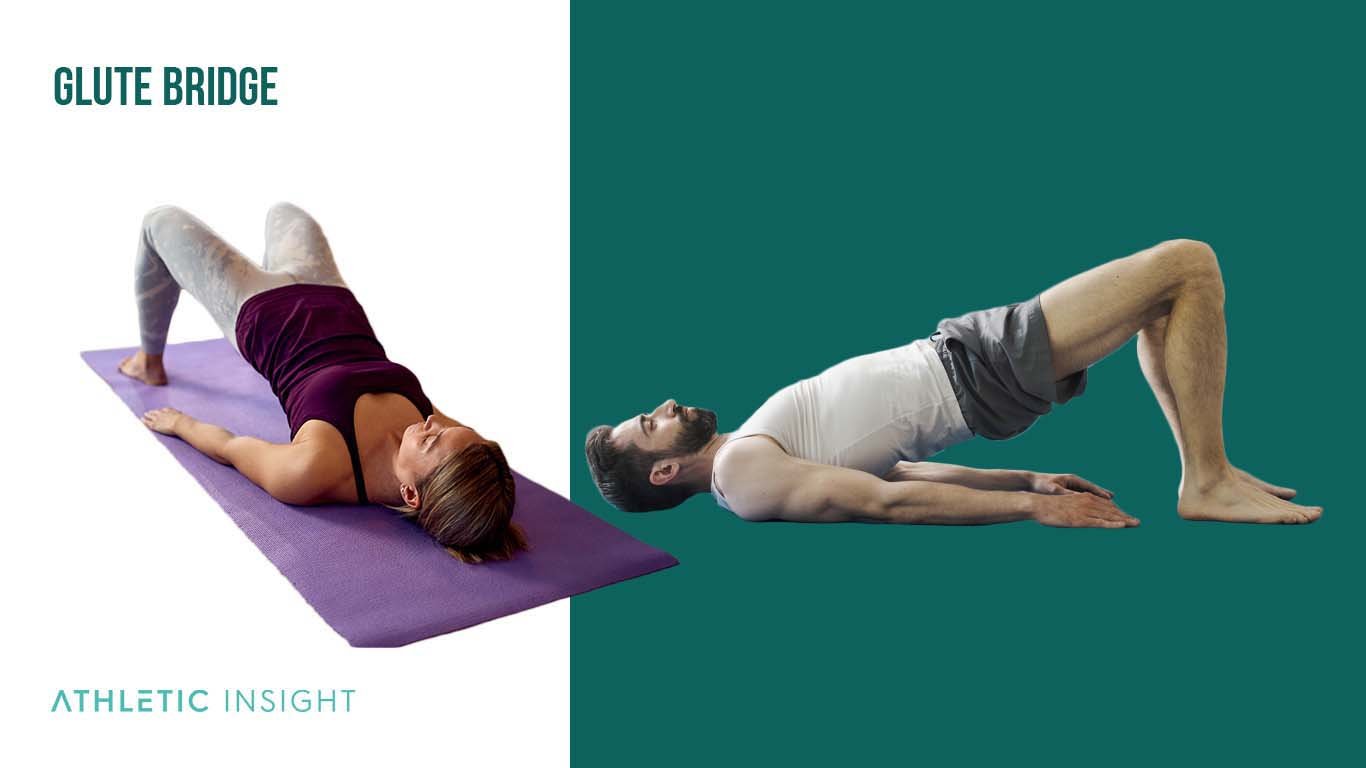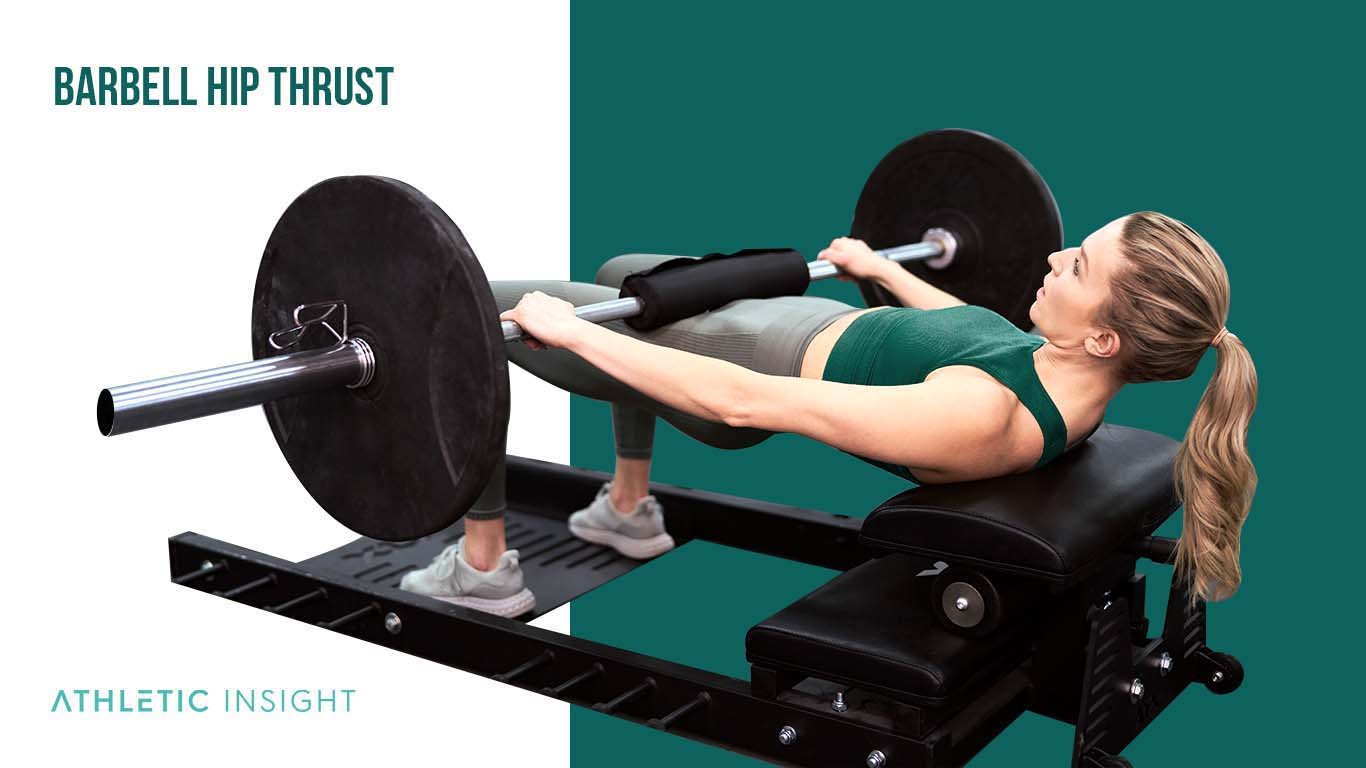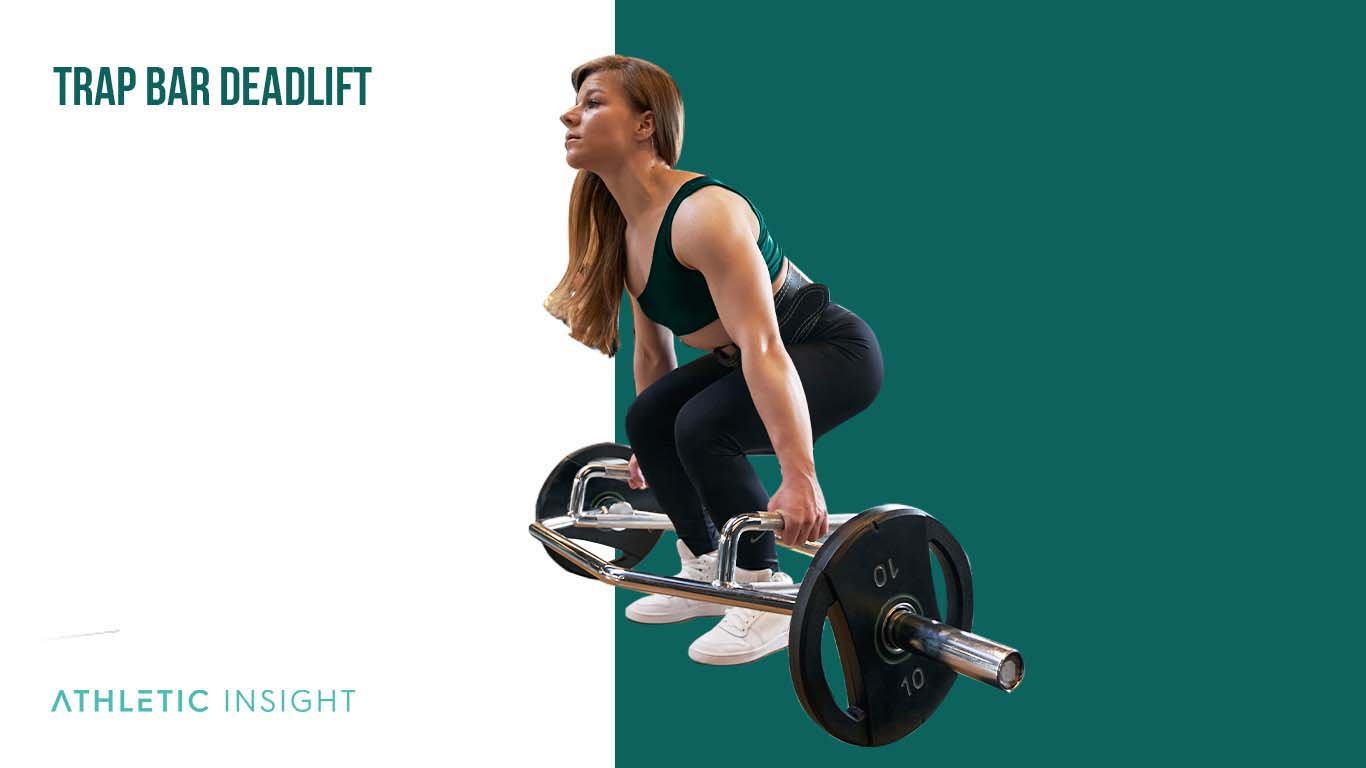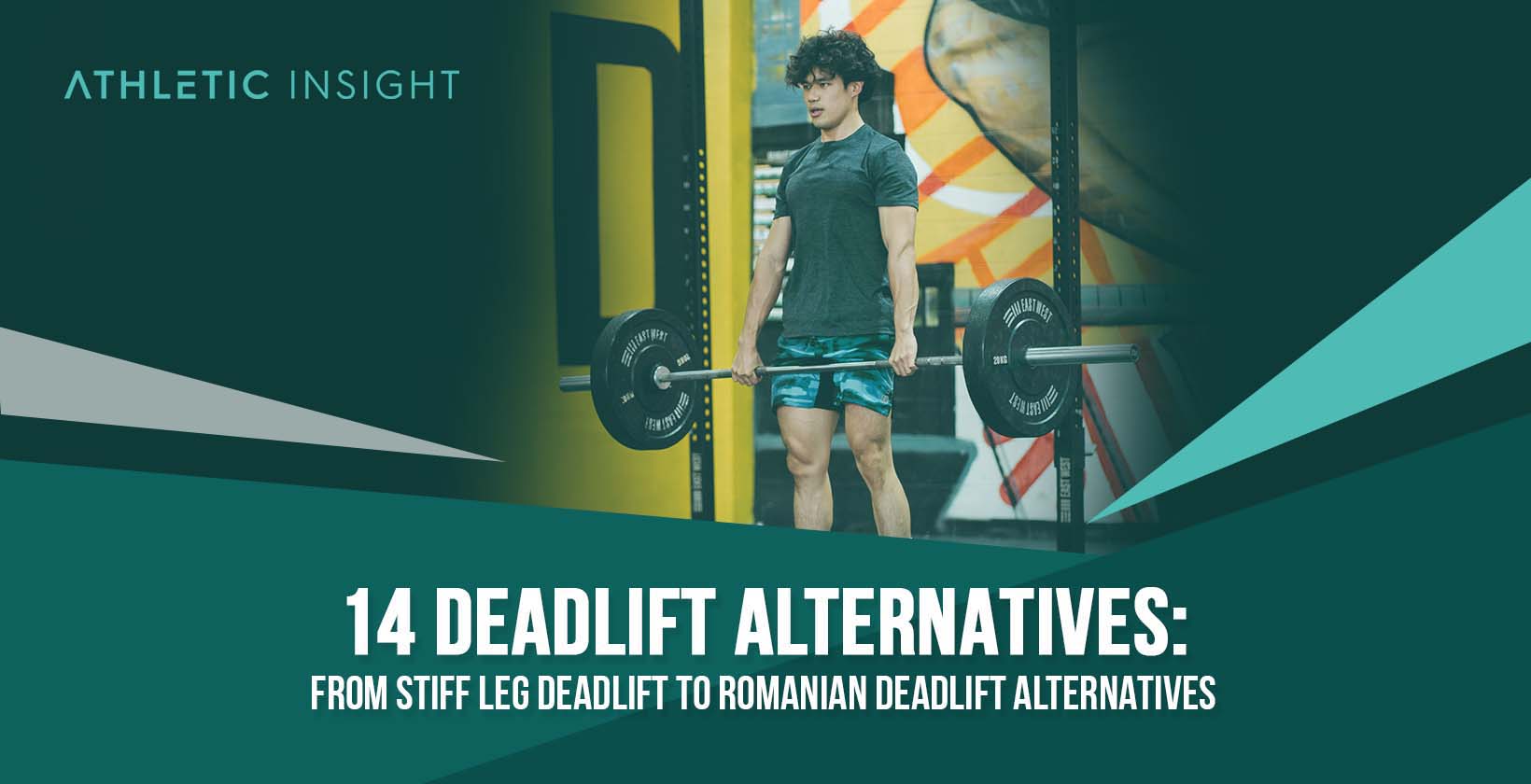Deadlift alternatives focus on the same muscle groups and movements as traditional deadlifts. A deadlift alternative is a must for someone seeking to place a greater emphasis on a specific muscle group associated with the deadlift, beginner lifters who have not mastered the deadlift form, and athletes that are coming back from an injury that prevents them from performing a traditional deadlift.
The deadlift is a popular lifting exercise for bodybuilders and weightlifters looking to see maximum gains throughout their bodies. Deadlifts can work muscles from your traps to your calves with a heavy emphasis on the glute, quad, and hamstring areas.
Deadlift alternatives are also beneficial when you cannot make it to the gym or do not have the proper equipment for a barbell deadlift. While deadlift alternatives are plentiful, the twelve listed below will help you target specific muscle groups without losing the integrity of the lift.
1. Glute Bridge
A Glute Bridge is a deadlift alternative that focuses on your butt muscles. Glute Bridge improves the gluteus maximus and hamstring muscles while strengthening the core. A Glute Bridge is better than a barbell deadlift to emphasize the posterior chain, specifically the upper butt muscles.

Performing Glute Bridge is less challenging than the deadlift. For a beginner-level weightlifter, the Glute Bridge exercise can be a choice to improve lower and upper body mass and strength when compared to other deadlift alternatives. A Glute Bridge is an ideal deadlift alternative if you cannot get to a gym and need a deadlift alternative at home.
A common mistake while performing a Glute Bridge is pushing through your toes instead of your heels. This does not put the main focus on the glutes but on the quads. To get the most out of the Glute Bridge to work your butt muscles, push through your heels to activate the gluteus maximus muscles and hamstrings.
2. Barbell Hip Thrust
A go-to weight training exercise that works the posterior chain is the barbell hip thrust. The barbell hip thrust is a deadlift alternative that focuses on the glutes and hamstrings. The barbell creates more resistance than the glute bridge making it a higher-level alternative.

Proper form is vital when performing the barbell hip thrust as the risk of back injury is evident. To prevent back injury, ensure the barbell is in line with your hips and your back is comfortably against a bench before performing the exercise.
This movement singles out the posterior chain ensuring your abdomen, hamstrings, and glutes are doing all the work. If you have a sensitive lower abdomen, you can place a mat underneath the barbell to create some cushioning.
Allowing your gaze to wander towards the ceiling is a common barbell hip thrust mistake. When it happens, your back begins to arch, taking the focus away from your glutes. To prevent this from happening, try keeping your chin down and your torso tight to ensure all activity generates from your hips.
3. Trap Bar Deadlift
The trap bar deadlift is an alternative to conventional deadlifts. The trap bar allows the bar weight to be in line with your body’s central gravity instead of in front as it is with a traditional deadlift. This center gravity weight makes the exercise easier on your back while still working the same muscles.

A trap bar deadlift is a full-body muscle activation as it strengthens and builds glutes, hamstrings, quads, lower back, lats, traps, and helps improve your grip. Advantages of the trap bar deadlift are the ability to lift heavier weights, put less stress on the lumbar spine, work your quad muscles more, and help you keep proper form.
A common mistake when performing a trap bar deadlift is the lack of back and core strength. Because this deadlift alternative helps you keep proper form and is easier to manage than a traditional deadlift, people tend to think they can load on as much weight as possible. To perform the trap bar deadlift, you must maintain core and back strength. If you don’t have this strength, you can’t effectively complete the exercise with the added weight.
Ensure your back is straight and your feet are hip-width apart before attempting to lift the bar. This will ensure you keep proper form and lower the risk of injuring your back during the exercise.
4. Block Deadlift
A block deadlift focuses on the upper end of the deadlift and is an alternative to a deadlift for back pain. Block deadlift is also a rack deadlift alternative, but instead of the bar weights sitting on the rack, they sit on blocks.
The block deadlift targets the glutes, upper back, and trap muscles and is an excellent default deadlift alternative for weightlifters and bodybuilders looking to increase upper body strength and glutes. Because block deadlifts require a shorter range of motion, you can lift more weights when performing this exercise.
While your glutes a mid-back can tolerate the added weight of the block deadlift, your grip may not be so fortunate. Wearing straps or gloves will help you keep your grip and maintain the ability to perform the deadlift.
If the straps or grip gloves don’t help, consider strengthening your grip by adding the farmer carry to your exercise routine. This exercise will help improve your grip and allow you to get the most out of the block deadlift.
5. Romanian Deadlift
The Romanian deadlift is a stiff leg deadlift alternative that focuses on the glutes and lower back. Romanian deadlifts can also improve hip mobility and balance. Contrary to a traditional deadlift, like the stiff leg deadlift, Romanian deadlifts are performed with little knee extension as lifters pull from the hips instead of the knees.
The Romanian deadlift is notable for beginners. While the form is easy to master if you’re used to regular deadlifts it may take longer to get the form down to a science. It is an exercise performed by athletes to tone their quads for optimal performance.
The nature of the Romanian deadlift means you don’t have to add much weight for it to be effective. Looking up while performing the exercise can cause your back to arch resulting in the risk of a back injury. Keep your chin tucked and look in front of you as you lower the weight.
Keep the weight close to your legs to prevent back injury. Hinge your hips back and keep your arms at your side to prevent the weight from drifting away.
6. Pendlay Row
Pendlay Row is a deadlift alternative that focuses on building back strength. An exercise of choice for powerlifters, the Pendlay Row does not require much leg strength as the bulk of the lifting strength comes from the upper body and back. The Pendlay Row is a notable stiff leg deadlift alternative since it uses a similar position but focuses on the upper body instead of the lower body.
Performing the Pendlay Row is an excellent deadlift alternative for those looking to bulk up their upper body and gain considerable strength in the lower and mid-back. A mistake lifters make when performing the Pendlay Row is standing too upright. Standing upright while performing this exercise causes lifters to use momentum to lift the bar. When this happens, they are not getting the full effect.
Keep your back flat and nearly parallel to the floor while selecting a manageable weight. This will help reduce injury risk and ensure you see maximum gains.
Pendlay Rows can be performed unilaterally if you wish to focus on one arm at a time. You can continually vary this deadlift by alternating your grip. Changing your grip can make a big difference in the gains you will see. For instance, an underhand grip will activate your bicep, while a close grip targets your mid-back.
7. Farmer Carry
While not a deadlift replacement, the farmer carry is an effective part of a deadlift routine. Farmer carry helps improve grip, which is a must to complete a deadlift with proper form. Improving grip is the most beneficial part of the farmer carry, but it can also benefit your entire body by strengthening the biceps, triceps, forearms, shoulders, upper back, quadriceps, hamstrings, calves, lower back, and oblique transverse abdominis.
The farmer carry is performed by grabbing a heavy dumbbell in each hand and walking forward with your chest up and shoulders retracted. A slight variation to the traditional farmer carry is to use a trap bar instead of dumbbells. Using a trap bar also allows you to use more weight if you do not have access to heavy enough dumbbells.
A farmer’s carry mistake is leaning forward at the waist. If you lean forward while performing this exercise, it can cause lower back pain. In turn, this will prevent you from maintaining proper form while exercising. Ensure you brace your core and stand tall when performing a farmer carry.
8. Bulgarian Split Squat
Bulgarian Split Squats focus on building muscle and strength in the quads and glutes. It is an alternative to the Romanian deadlift because it activates your glutes and heightens quad stability. Bulgarian Split Squats are an excellent deadlift alternative if you are looking to manage particular muscular imbalances because you can perform the squat with each leg independently.
The Bulgarian Split Squat should be selected as a Romanian Deadlift alternative when focusing on one leg more than the other. Romanian deadlifts don’t offer this type of flexibility. Bulgarian Split Squats are performed with weight. However, if you are a beginner or just learning the exercise, you must get your form down before adding weight.
The Bulgarian Split Squat is an excellent alternative option for athletes looking to build lower-body mass. It is also used for athletes coming back from a leg injury who need to focus on reactivating the quad and glute on a specific leg.
One common mistake made while performing the Bulgarian Split Squat is allowing the front knee to shift. You will lose alignment if the knee shifts inward, outward, or side to side, which is often a sign that your stability does not support the weight you are using to exercise. To fix this mistake, ensure you have the motion down before adding weight.
9. Deficit Deadlift
The deficit deadlift is a barbell deadlift alternative that focuses on the quad muscles. Deficit deadlifts start with the lifter standing on an elevated platform. This elevation creates an additional range of motion, causing your lower-body muscles to work harder. Deficit deadlifts also work the glutes, hamstrings, calves, erector spinae, upper back, and lower back.
The deficit deadlift is recommended for experienced lifters such as bodybuilders and advanced athletes. If you struggle with a regular deadlift, do not attempt the deficit deadlift. As with all deadlift variations, if not performed correctly, it can cause serious injury particularly lower back injuries.
Variations of the deficit deadlift include changing your stance from the shoulder-width, to sumo style. The sumo position works a different muscle group for a greater challenge. Before attempting a deficit deadlift, ensure the bar is touching your shins, and you set your hips slightly lower than for a regular deadlift.
10. Pause Deadlift
Pause deadlift is a deadlift alternative that helps improve technique and increase strength. The pause deadlift isolates your quad muscles by emphasizing them when you pause for 1-2 seconds. This pause breaks up the fluidity of a regular deadlift as the pause comes halfway through the range of motion in a deadlift.
This type of deadlift alternative is beneficial for athletes or bodybuilders who have mastered the deadlift technique and are looking for muscle gains in the lower body. This is not a deadlift alternative for beginners as it takes the knowledge and skill of a traditional deadlift to the next level.
When performing a pause deadlift, ensure you are not arching or relaxing your back. You want to maintain a start position similar to a regular deadlift; a 45-degree angle. Arching your back can cause back problems and prevent you from lifting until your back has healed. The bar should not surpass your knees and remain close to your shins to get the most of the lift.
11. 45-Degree Back Extension
45-Degree Back Extensions is an alternative to barbell deadlifts and focuses on building muscle and strength in the lower back and glutes. Because the motion and machine are easy to master, 45-degree back extensions are an excellent deadlift alternative for beginners. If you don’t have access to a 45-degree back extension machine, you can substitute the exercise with a hyper-extension, glute-ham raise, or reverse hyper and receive the same results.
Adjust the back extension to a comfortable bend at your waist, then select a dumbbell or weight and hold it to your chest. Position your feet and begin lowering yourself towards the floor while keeping your legs straight and your spine neutral. Bend until you feel the motion in your hamstrings/glutes, then return to the start position using your core and legs.
To perform the back extension properly, you want to ensure your movements are slow and under control. Using rapid movements is a common mistake that can result in a back injury. Refrain from using momentum to lift yourself and adjust the weight so you can remain under control while performing a 45-degree back extension.
A variation to the 45-degree back extension is to slightly round your mid-back. This puts a greater emphasis on the glutes and less strain on the lower back. If performing this variation, ensure to use a lighter weight and concentrate on squeezing your glutes throughout the exercise.
12. Standing Cable Pull Through
With a primary focus on glutes and hamstrings, the standing Cable Pull-Through is a barbell deadlift alternative that works the same muscles. Standing cable pull-throughs can easily be modified to emphasize the specific muscles. Such target areas include the adductor Magnus or inner thigh, and glute medius or upper side glute and can be accomplished by taking a wider stance. Take a narrower stance if you wish to work your hamstrings and glute max.
You can maintain constant tension on your muscles by using the cable machine to perform Standing Cable Pull-Throughs, allowing you to see greater gains in a shorter period. A common mistake when performing the Standing Cable Pull-Through is placing the weight at the heel of your foot instead of the front, which can throw you off balance and render the exercise ineffective.
To perform a Standing Cable Pull-Through, you must maintain proper balance which is done by placing the weight at the toes instead of the heel throughout the movement. By doing this, you can focus more on the muscle you are exercising instead of keeping your balance.
You also want to ensure you have a slight bend in your knees and keep your back in a neutral position. Standing Cable Pull-Throughs is not for beginners and should be performed only when you are comfortable with the machine and can find your balance. You can substitute Standing Cable Pull-Throughs with a kettlebell swing, although the kettlebell swing has a more explosive movement.
What to know about deadlift alternatives?
Deadlift alternatives are convenient for those that have suffered injuries and are unable to perform a regular deadlift. They also benefit those attempting to target a specific part of the body.
Which deadlift alternative is beginner friendlier?
The 45-degree back extension, glue bridge, and Romanian deadlift are all deadlift alternatives that are beginner-friendly. These alternatives allow room for growth and are the type of exercise that is easy to get the hang of. Like all other exercises, it is vital to understand and perform the exercise in the correct form.
Which deadlift alternative is better for the butt?
The glute bridge, barbell hip thrust, Bulgarian split squat, 45-degree back extension, and Romanian deadlift are excellent deadlift alternatives if you are looking to grow your butt strength. While most, if not all deadlift alternatives help build muscle in your glutes, these deadlift alternatives have the biggest glute impact.
Which deadlift alternative is better for the back?
Back pain is a common side effect of improper deadlift form. The 45-degree back extension, trap bar deadlift, and block deadlift are deadlift alternatives to ease the stress on your back. Adding the deadlift to any back exercise routine will help develop the back muscles.
Which deadlift alternative is better for strength?
Each deadlift alternative, when performed properly, will help you build strength. However, if you are looking to bulk up fast and in a short timeframe, the trap bar deadlift, Romanian deadlift, farmer carry, and barbell hip thrust are the best deadlift alternatives for better strength.
When should an athlete use deadlift alternatives for exercise?
Because the deadlift exercise is effective in developing strength, speed, power, and overall muscular endurance, the deadlift is recommended for athletes of all sports. However, athletes who are returning from an injury and can’t work a specific area should consider using some of the various deadlift alternatives, especially if they want to focus on a specific muscle group.
Can deadlift alternatives replace the barbell deadlift?
Yes, deadlift alternatives are an excellent way to replace the barbell deadlift. As previously mentioned, the varying alternatives focus on specific muscle groups. One of the most highly effective deadlift alternatives is the 45-degree back extension. It works for the same muscle groups but is easier on your posterior chain.
Which deadlift alternative movement is best?
If you want to work on the same target muscle groups, the 45-degree back extension is the best deadlift alternative movement. The Romanian deadlift is the alternative you will see the most return on muscle growth.
What are the different Deadlift variations?
While there are different exercises you can perform that will replace the deadlift entirely while still working the same muscles, there are also deadlift variations you can try. These deadlift variations are different ways in which you can perform a deadlift movement, that alters the exercise and sometimes the muscles in different way. The most popular deadlift variations are the Romanian Deadlift or the Sumo Deadlift.



